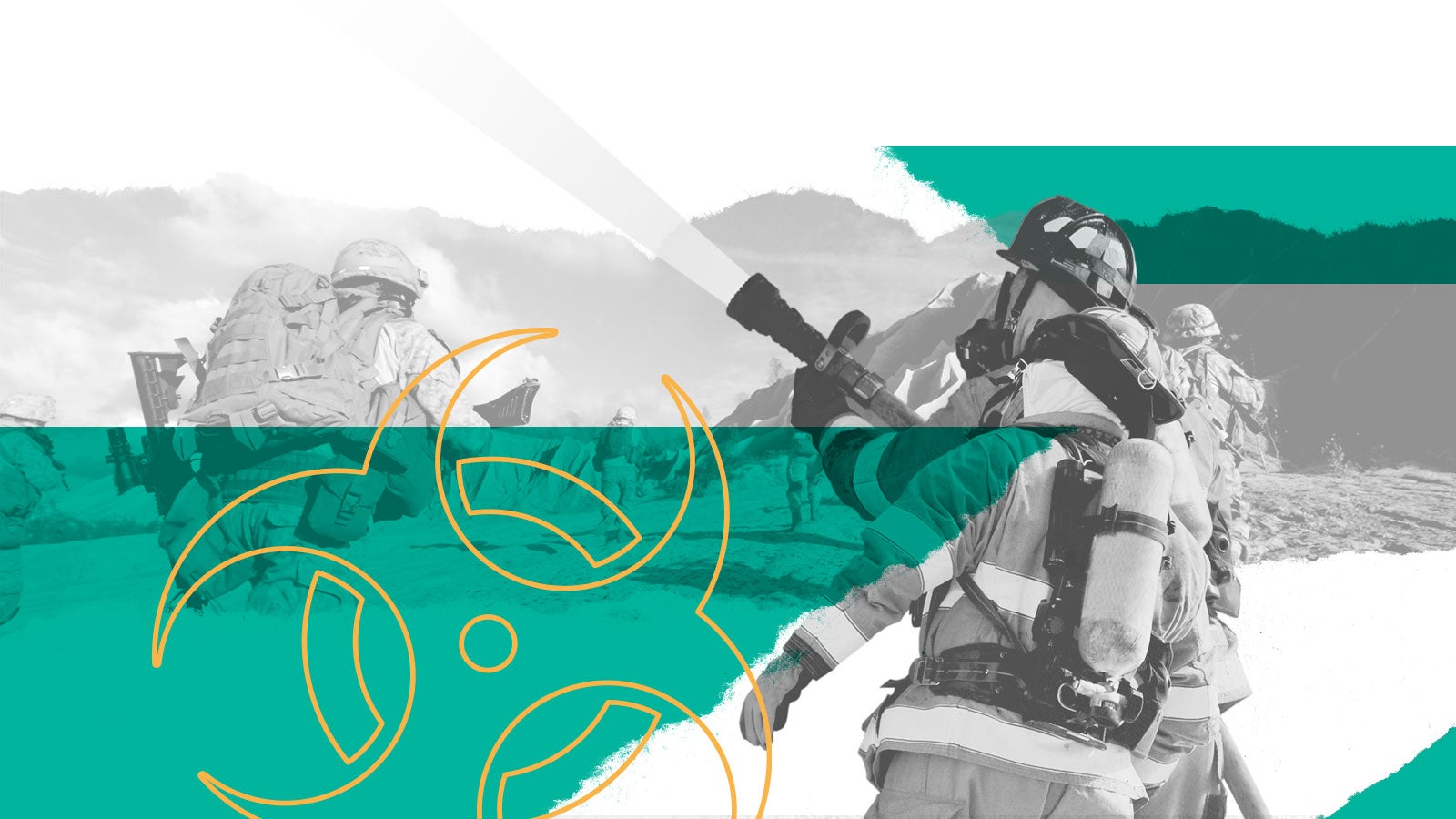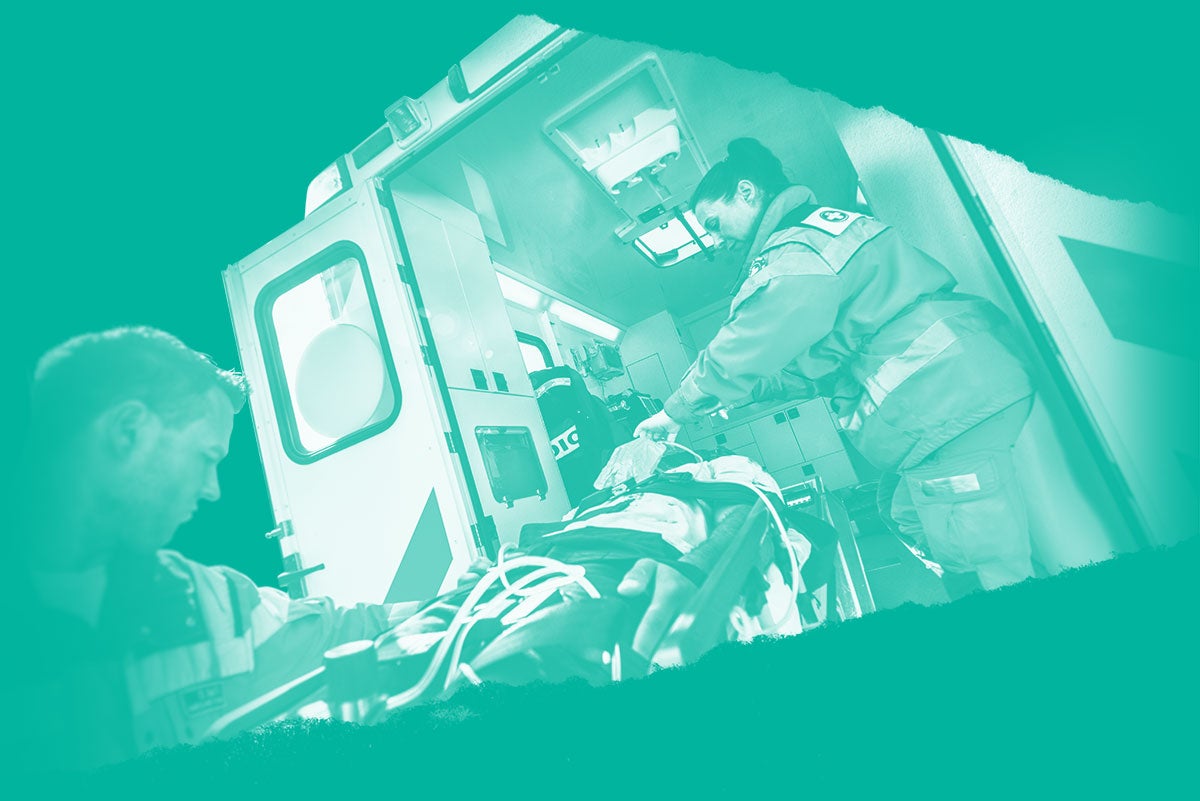
Helping the Helpers
Fall 2019 | By Jenna Marina Lee
“This means I promise to keep you safe,” says Orange County Sheriff’s Office Lt. Ashley Strange ’05 ’07MS, while pointing to the star badge on her uniform.
Her vow is at the heart of her job duties as a featured police officer on WUCF TV’s Meet the Helpers, a multiplatform project for teaching children about first responders and other community helpers and better preparing them for emergency situations.
Named after Mister Rogers’ famous advice to “look for the helpers,” the series introduces viewers to seven professionals — from paramedics and 911 operators to teachers and meteorologists — who help during emergencies. It was developed under the advisement of Judith Levin ’86MEd, associate lecturer and program coordinator for Early Childhood Development and Education.
In July, the Corporation for Public Broadcasting gave $250,000 to WUCF to support the project, which was created in response to the 2016 Pulse nightclub shooting. The funding will focus on emergency preparedness, youth stress and anxiety, and crisis communications.
As UCF works to make Meet the Helpers a national model, the university is also committed to improving the quality of life for first responders.

Healing Trauma
Since its start in 2011, UCF RESTORES has become known nationally for its innovative PTSD treatment for veterans, active-duty military members, first responders and other victims of trauma.
The program’s unique approach to treatment — including its groundbreaking three-week intensive outpatient program — combines exposure therapy, emerging technology and group therapy sessions to treat patients. For example, through virtual reality, patients are exposed to the sounds, smells and sights that have contributed to their PTSD, helping them work through possible triggers.
Backed by funding from generous private donors, the Florida Legislature, and grants from the Department of Defense and U.S. Army, UCF RESTORES has treated nearly 500 veterans and active-duty personnel, and has expanded its services to treat more than 200 first responders from 20 states. The organization has also served survivors of mass shootings.
In March, UCF RESTORES announced it was teaming up with the Florida Firefighters Safety and Health Collaborative to streamline access to support, resources and treatment for more than 350 departments around the state.
Until now, UCF RESTORES has leveraged third-party technology for the virtual reality element of its treatment, but that’s about to change thanks to funding from Congress and a partnership with the UCF School of Visual Arts and Design, the UCF Nicholson School of Communication and Media, the UCF Institute for Simulation and Training, and E2i Creative Studio. The proprietary VR technology will allow UCF RESTORES’ therapists to dynamically recreate traumatic scenarios specific to each participant.
Located on UCF’s main campus and Brevard campus, UCF RESTORES currently provides free treatment for Florida residents.

Preventing Exposure to Deadly Chemicals
Imagine a device that resembles a mix between a Star Trek phaser and a baseball radar gun that can detect deadly toxins.
That’s what UCF engineering Associate Professor Subith Vasu is developing after receiving a $1 million grant from the Defense Advanced Research Projects Agency.
Vasu’s energy-efficient handheld device would have the capability for remote detection of fentanyl and Carfentanil — opioids that are 50 to 10,000 times more potent than heroin. When dispersed in the air, the chemicals can kill, even if the exposure is minimal.
The device’s sensor would also detect similar toxins, sometimes released in fires or explosions and used in chemical warfare, which pose threats to first responders and military personnel.
“The goal is to combine laser technology with artificial intelligence in a compact and rugged device people in the field can use,” Vasu says. “We want to keep our military and responders safe while they keep us safe.”

Interpreting Dangerous Signs
The Orange County Fire Rescue Department posed a challenge to the UCF Institute for Simulation and Training: “Can you clone our best trainer?”
While the institute may not have had the capability to actually clone a human, program director Eileen Smith believes the institute’s E2i Creative Studio came up with the next best thing: the Firefighter Incident Command Training Simulator.
For the past seven years, the fire department has used the simulator as a tool to train new lieutenants, captains and battalion chiefs. With the click of a few buttons, the program allows for dozens of fire situations to immerse future incident commanders in seven different environments, ranging from a forest to a home. Within each simulation are cues that the incident commander needs to recognize to make critical decisions.
There might be toys in the yard or a car in the driveway, suggesting that someone might be trapped. A propane tank beside a building or a certain kind of smoke can indicate impending hazards to firefighters. The trainee has to recognize the clues, make fast and accurate decisions, and actively call out the commands to manage the situation, gaining experience in weeks that would otherwise take years.
The scenarios typically last 20 minutes, compressing hours of real-life incident command decisions that occur during a real fire. This helps prepare lieutenants, who are usually the first officers on the scene, on how to transfer critical information to the battalion chief when he or she arrives and takes over command.
“What are you handing them in 20 minutes? It could be a catastrophe, or you could already have the fire down,” Smith says.
OCFRD says that the system has helped their department increase confidence in their training and their command officers.
“When we initially began using the simulator, we could tell who had taken the training based on their radio communications on actual incidents,” says OCFRD Deputy Chief Jim Fitzgerald. “They were using standard, command terminology and asking better questions. They were communicating commands more effectively and preparing incoming units to operate more effectively when they arrived. It increased their confidence and competence. And when every second counts, that matters in a big way.”
The lab’s next simulation project is a research testbed for unified incident command, which would allow police, fire and emergency medical technicians to train together to respond to events such as a hostage situation, mass shooting or hurricane evacuation, so they can understand how to avoid it or work through the situations as a team more efficiently.

Identifying Impaired Drivers
UCF police officer Frank Imparato is on a mission to make roads safer in Central Florida, the state and nationwide.
Imparato, who joined the UCF Police Department in 2011 and serves as supervisor at UCF Downtown, is one of five certified drug-recognition expert instructors in Orange and Seminole counties.
He regularly hosts instructional DUI trainings for Central Florida police officers, from rookies learning protocol to 20-year veterans on the force who need a refresher. The National Highway Traffic Safety Administration mandates 24 hours of curriculum for police officers nationwide, but Imparato has extended his lesson plans to 32 hours to include other helpful hands-on experiences.

“I take pride in having the city of Orlando, Orange County Sheriff’s Office, Seminole County Sheriff’s Office and the Florida Highway Patrol calling upon UCF to educate and train their officers and assist them in investigations.”Frank Imparto, UCF Police Officer

Imparato puts his trainees through a mock trial interrogation with defense attorneys and prosecutors, which allows officers to practice testifying as a witness in court. He also supervises a wet lab exercise that enlists volunteers to become inebriated just past the legal limit so officers can learn to interpret signs of impaired driving correctly and with more accuracy.
In addition to his service at UCF, Imparato is an instructor at Valencia College’s Law Enforcement Academy and also collaborates with the University of North Florida’s Institute of Police Technology and Management to teach various topics to officers from around the country.
“I am only one person, but if I can pass on that knowledge to officers, not just at UCF but around the country, maybe they can save a life so someone gets to go home that night,” Imparato says. “I take pride in having the city of Orlando, Orange County Sheriff’s Office, Seminole County Sheriff’s Office and the Florida Highway Patrol calling upon UCF to educate and train their officers and assist them in investigations.”

Detecting Signs of Domestic Violence
According to a study in the Journal of Emergency Medicine, women who have been previously choked by their partner are over seven times more likely to be killed in the future.
So when the Brevard County Sheriff’s Office contacted the UCF Department of Sociology in 2014 about improving its officers’ ability to identify nonfatal strangulation in domestic violence cases, Associate Professor Amy Reckdenwald jumped on board.
Over the last five years, Reckdenwald, who specializes in domestic violence research, and her colleagues teamed up with law enforcement, public health practitioners, local domestic violence victim advocates and the state attorney’s office to develop the Brevard County Strangulation Prevention Program, a coordinated effort to teach law enforcement officers how to better identify and document choking and refer victims to forensic medical exams. The program also trains sexual-assault nurses how to accurately document forensic evidence of a strangulation assault during an exam and testify as expert witnesses in court.
“One may think you’d easily notice signs of strangulation; bruises around a victim’s neck, for instance, are commonly thought to be a clear indication of strangulation. While that may be the case, research has shown that the majority of strangulation victims do not have any visible signs of injury,” Reckdenwald says. “And even though strangulation is a felony offense in Florida, there is no required training to empower police officers to accurately identify it. This lack of corroborating evidence that the strangulation took place results in many cases being unable to be prosecuted.”
Reckdenwald says the program has been a success. Findings from the evaluation showed officers were able to identify strangulation with more accuracy, and more cases with forensic evidence were sent to the state prosecutor’s office. As a result, 70.8 percent of explicit strangulation cases that had forensic evidence had sufficient evidence for the prosecutor to file a criminal charge, which was significantly higher than the 46.6 percent filed previously. Additionally, explicit strangulation cases with forensic evidence were prosecuted at a more stringent level than cases without forensic evidence.
Training for officers is still taking place in Brevard County, and the program is looking for continued funding to be able to provide forensic medical exams to victims of choking.

Reducing Exposure to Radiation
This year’s HBO miniseries Chernobyl was a massive hit with audiences and critics but left some fearing what might happen if a nuclear disaster occurred in our own backyard.
UCF industrial engineering doctoral student Buder Shageer ’13MS is researching that concern in his quest to develop tools for nuclear-disaster response. Using data from the 2011 disaster at the Fukushima Daiichi Nuclear Power Plant, Shageer is simulating a similar disaster at the St. Lucie Power Plant in Jensen Beach, Florida.
In March 2011, Fukushima, a coastal nuclear power plant in Japan, experienced a Level 7 meltdown — the same level as the 1986 disaster at Chernobyl — after an earthquake and subsequent tsunami knocked out the plant’s primary and backup power supplies. The loss of power disabled the cooling process for three reactors, resulting in overheating, explosions and radiation released into the air and surrounding ocean.
Shageer’s advisor, Michael Proctor, associate professor of industrial engineering and management systems, says lessons learned from Fukushima’s accident prompted U.S. nuclear plant managers to take precautions to guard against such disasters. Nevertheless, a Florida coastal nuclear plant runs the same risk of power outage from a major hurricane and catastrophic storm surge.
“It’s probably less than a 1 percent chance that something like this would happen at St. Lucie, but the potential scale of what might happen is so large that it’s important to address,” Shageer says. “These disasters are not a one- or two-year event. The effects last decades.”
In addition to improving disaster response, Shageer’s research would help improve the safety and well-being of first responders.
Combining data from the Nuclear Regulatory Commission and real-life flight dynamics, Shageer is determining how unmanned aerial vehicles — in this case, helicopters — can deliver water precisely to reactor cooling pools despite radiation in the air.
Helicopters may be an important first line of defense in response measures as storm surge may knock out bridges and roads, as seen in Hurricane Katrina and Superstorm Sandy. But manned helicopters can be dangerous and ineffective. At Chernobyl, one crashed, killing all on board, after its electronics and operations system failed due to radiation exposure. At Fukushima, helicopters flew so high to avoid dangerous radiation and reactor debris that water dumps to cool reactors were futile.
Shageer’s simulation would ensure that doesn’t happen by determining electronic radiation hardening requirements for helicopters until ground vehicles reach the disaster site and assume operations. His simulation can be applied to any nuclear disaster situation by modifying parameters such as radiation leak rate, the number of compromised reactors and radiation hot spots, time of day, wind direction, and location of the nearest source of fresh water.
The simulations can model ground scenarios involving groundshine — the radiation emitted from radioactive materials on the ground — which is a big threat to surrounding communities and first responders on the ground.
“This would help map better recovery plans and give communities and first responders the ability to plan for and contain a disaster,” Shageer says.
